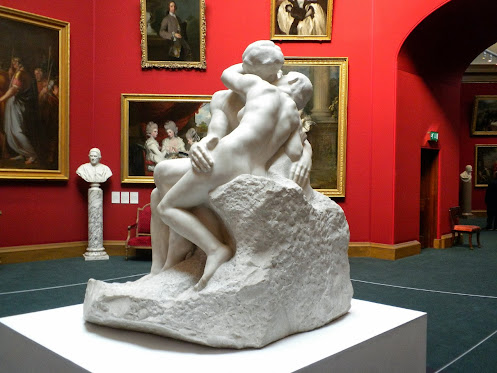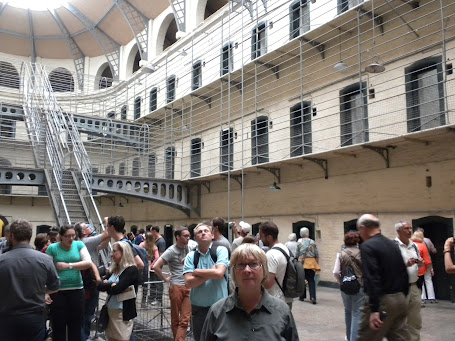Carol writes:
New Lanark
was the brainchild of Robert Owen, the manager of the mill and the man behind a
great social experiment that was conducted in the early 1800s at the New Lanark
textile mills. Owen was very progressive
in his thinking and believed that society could be free of crime, poverty, and
misery; the key, he believed, was education.
For the workers at New Lanark, he provided decent homes, fair wages,
free health care, the first workplace nursery school in the world, and a new
education system. The restored
schoolhouse was especially cheerful.
We were
fascinated when we saw the operation of some of the large old machinery for
winding New Lanark yarn onto spools.
As we walked
through the house that Robert Owen lived in, it was interesting to discover
that he had transported his progressive social ideas to the United States and had
tried to set up a town similar to New Lanark in a place called New Harmony,
Indiana. However, due to insufficient
financial backing, his ideas just never quite caught on in New Harmony.
THE LAKE
DISTRICT: During many of our conversations with fellow
travelers, the one comment that has been repeated most often is, “You must not
miss the Lake District.” As soon as we
entered the Lake District, it wasn’t hard to appreciate what all the talk had
been about. The lakes with their surrounding
idyllic scenery formed the most spectacular English scenery we had seen to
date. We were determined that as long as
we were in the Lake District we would take a hike around one of the lakes, no
matter what the weather. With its bucolic
lake beauty and charm, the 4-mile loop around Lake Buttermere seemed a perfect
idea…that is until we were 2 miles into the hike--past the point of no return--and
it started to pour. Gradually, what we
have come to call “soft weather” had become a soaker.
However, there
was a section of our lake hike through a field of sheep that was so bizarre that
we almost didn’t mind getting drenched.
Hundreds of sheep in the field around us were standing still as if
frozen in place. None of them were
eating, none of them were lying down, and none of them were moving! Some of them seemed halted in
mid-stride! Perhaps that is typical
sheep behavior when it is raining, but it looked very weird. Other hikers from the UK remarked to us that
they had never seen such sheep behavior before.
Obviously, this snapshot with a camera couldn’t quite capture how frozen
in time this entire herd of sheep appeared to us.
We felt
relieved when we got back to the RV where we could get out of our wet
clothing. Eventually, it took 3 days to
dry out everything that had gotten soaked. However, as one of our campground
wardens told us, “If it wasn’t for the rain, we wouldn’t have the lakes.” I suppose that’s the practical Lake District way
to look at rainy days.
We rounded
out our time in the Lake District with a tour of Honister Slate Mine,
a visit to
Dove Cottage, where England’s Poet Laureate William Wordsworth lived for nine
years,
and a stop
at 5000-year-old Castlerigg Stone Circle.
As at other
standing stone sites, several meaningful alignments in the placement of the
stones at Castlerigg have been discovered.
YORK: The city of York has played such a pivotal role in British
history. The ancient walls of York lay
claim to Roman history, Viking history, medieval history and Industrial Age
history, so it is no wonder that today its chief industry is tourism. Its visitors want to experience some of that
history!
The jewel of
York is the largest Gothic cathedral north of the Alps—the grand York
Minster. Since it was not part of an
abbey, the Minster was spared destruction during the reign of Henry VIII. During WW II, its priceless stained glass
windows were hidden in private homes to protect them from German bombs.
When we
inquired about attending evensong on Sunday afternoon, we were told that a new
pastor was being installed that day and that evensong service would last a
little longer than usual. Our timing was
fortuitous… There is no better way to
appreciate the musical and spiritual essence of a grand cathedral in Europe
than to attend one of its services. The
acoustics and ambience of a wonderful cathedral like York Minster certainly
enhanced our choral evensong experience.
The choir sounded heavenly. There
was quite a festive atmosphere at the conclusion of evensong when everyone
wanted to greet the new pastor and welcome him to the ‘Minster.’
Our last day
in York was a rainy one, so we decided to take in two of York’s best museums. The York Castle Museum has been dubbed
“possibly the closest thing to a time-tunnel experience” with its incredibly
detailed life-size reproductions of rooms from the 17th through the
20th centuries,
along with a
re-created life-size Victorian street called Kirkgate that was lined with shops
and businesses. As we wandered through
the shops of Kirkgate, background sound effects typical of a Victorian-era
street contributed to the time-travel experience.
The other
museum we visited in York was the National Railway Museum. Typically, at the mention of a train museum,
my eyes start to glaze over—not my favorite topic of interest. However, throw in several tracks of
beautifully restored royal trains and my interest increases dramatically. The museum had wonderfully restored royal
train cars that were used by Queen Victoria, King Edward VII, and Queen
Elizabeth II. It was difficult to get
good photos through the windows of the royal cars. The best of the pics included this one of
King Edward’s smoking room lounge car with its oversize green leather armchairs,
and the pic
of the bathtub in King Edward’s private bath car.
Brontë Parsonage: The Brontë
family is perhaps the world’s most famous literary family. In preparation for our visit to Brontë
country, I had recently read both Jane
Eyre by Charlotte Brontë and Wuthering
Heights by her sister Emily Brontë.
Both of these literary masterpieces were written at the Brontë Parsonage
family home in Haworth where Patrick Brontë, the father of the six Brontë
children, was pastor of the church. The furnished
rooms in the parsonage captured an authentic atmosphere from the days when the Brontë
family lived there. Display cases were
filled with a fascinating wealth of clothing, personal possessions, paintings,
letters and notebooks from various members of the family.
The
next-door church graveyard seemed awfully spooky on the cold, windy, rainy day
of our visit.
It was
especially interesting to see the actual moors in the distance that inspired
Emily when she wrote Wuthering Heights.
In the early years, life in the Brontë household was a
happy time around the dining room fireplace where the three sisters (Charlotte,
Emily, and Anne) supported, inspired and critiqued one another in their
individual literary pursuits. However,
as the rest of the family story unfolded, it became clear that it was a tale
with few happy endings. The mother of
the Brontë children died of cancer at age 38 and left her young children to be raised by her sister at
the parsonage. Charlotte lived longest of
the six children and also died at age 38, in the early stages of pregnancy only
9 months after her wedding day. The
father of the Brontës died in his 80s, having outlived his wife and all six of
his children. What a burden to
bear! It is remarkable how in such a
relatively brief number of years this talented literary family caught the
attention of the world. The fascination
has never lagged to this day.
“Any relic of the dead is precious, if they were valued
living.” Emily Brontë, Wuthering Heights
































































